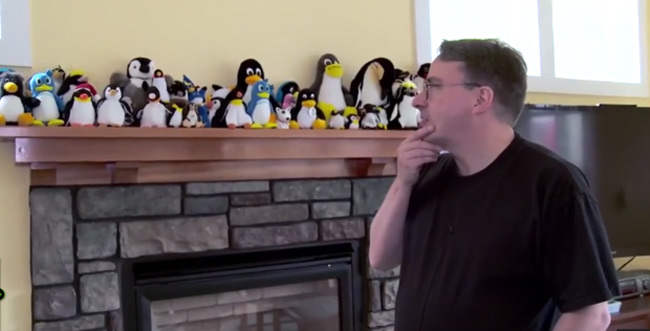Linux turns 30 years old: Memorable milestones from the first day of its establishment until now
On August 25, 1991, Linus Benedict Torvalds - a Finnish student who had just graduated - announced on the Usenet group comp.os.minix that he was working on 'an operating system (free, just a hobby) , won't be as big and professional as gnu) for the AT 386(486)' generation of chips. That is the Linux operating system. No one, not even Torvals, knows that technology changes the world forever.
30 years later, Linux dominates the world of information technology. Most major websites, including Google, Facebook, and Wikipedia, and the cloud run Linux. Even Microsoft's Azure uses Linux. In addition, all 500 of the world's fastest supercomputers run Linux. Thanks to Android, Linux is the most popular end-user operating system.
 Linux turns 30 years old: Memorable milestones from the first day of its establishment until now Picture 1
Linux turns 30 years old: Memorable milestones from the first day of its establishment until now Picture 1
Sharing about Linux, Torvalds feels both pleased and amazed at the vitality of Linux.
On the occasion of Linux turning 30 years old, let's take a look back at the memorable milestones of this operating system!
Lunix's lipstick milestones over the past 30 years:
- August 25, 1991: Torvalds sends a message to the Minix Usenet group, sharing about Linux.
- 1992: Andrew Tannenbaum, OS expert and creator of Minix, declares 'Linux is obsolete'. From there, broke out the first war of Linux. In a discussion, Torvalds made a very nice comment about his vision for Linux, which is still true today: 'If the GNU kernel had been ready last spring, I wouldn't have bothered to let it be. started my project: the truth is it wasn't and still isn't. Linux wins strongly thanks to the points it has now'.
- In 1993:
-
- Slackware by Patrick Volkerding was the first distribution to be widely successful and it is still being updated and used today.
- Launch of Debian Linux.
- 1994: Marc Ewing creates Red Hat Linux. Bob Young then bought the company and merged with his company, creating Red Hat. This is the most successful Linux company to date.
- 1995: Linux has its first trade conference, Linux Expo.
- In 1996:
- KDE, the first Linux desktop interface, is released.
- SUSE, Europe's leading Linux enterprise, releases the first standalone Linux.
- 1997: Miguel de Icaza and Federico Mena began work on a new Linux desktop - GNOME - built entirely on free software. It joins KDE as one of the two most important Linux desktops.
- 1998: Microsoft begins to see Linux as a rival and launches campaigns against Linux and open source.
- 1999:
- Corel released the first desktop computer using Linux.
- Linux was compared to Windows NT for the first time and Linux won.
- 2000: IBM announces a $1 billion investment in Linux.
- 2001: Linux 2.4 is released.
- 2003: SCO, formed from the old SCO Unix company and the Caldera Linux company, turns away from Linux, IBM, and others. SCO tries to prove that Linux is a clone of Unix.
- 2004:
- Ubuntu was created, becoming the hugely popular Linux desktop operating system and the most important of all Linux cloud distributions.
- More than half of the world's fastest supercomputers run the Linux operating system.
- 2007: Google and many other hardware companies launch Android. Linux has become the most popular end-user operating system, running on more than 1 billion smartphones.
- 2008: The New York Stock Exchange switched to using the Linux operating system. This marks Linux officially as big business.
- 2009: IBM's Watson runs Linux.
- 2011: Google first launches Chromebook (CR-48), running Chrome OS based on Gentoo-Linux.
- Year 2012:
- IT begins to move from servers and data centers to the cloud and the cloud runs on Linux.
- Red Hat becomes the first multi-billion dollar open source company. In 2016, it became the first Linux business worth $2 billion.
- 2014: Satya Nadella, CEO of Microsoft, declares Microsoft loves Linux.
- 2017: All of the world's fastest supercomputers run Linux.
- 2018: Microsoft opens the Open Invention Network team to protect all Linux patents.
- In 2019:
- Microsoft introduces its own native Linux, Windows Subsystem for Linux 2.0, to Windows 10. Users can run Linux and run Windows at the same time.
- Red Hat was acquired by IBM for $34 billion, making it the largest software acquisition ever. Therefore, Linux is clearly positioned in the tech world.
- 2020: 90% of the global cloud runs Linux. More than half of Microsoft Azure's virtual machines are Linux.
You should read it
- What do you know about Linux distros?
- 14 interesting Linux commands in Terminal
- The 5 most awaited things in Linux in 2019
- Compare the most popular Linux distributions today
- 3 main types of Linux distributions that you should know
- How to back up and restore Linux Terminal history
- 7 best Linux distributions based on Red Hat
- History of Linux operating system, a strange development path
- Basic Linux commands everyone needs to know
- How to use the history command in Linux
- What's new in Linux Kernel 5.18?
- 6 reasons why the Linux operating system often fails






 Gmail: 9 years and memorable milestones
Gmail: 9 years and memorable milestones 5 most memorable milestones of 2016 of artificial intelligence
5 most memorable milestones of 2016 of artificial intelligence 15 memorable development milestones of the web browser
15 memorable development milestones of the web browser History of Earth formation and 25 milestones (Part I)
History of Earth formation and 25 milestones (Part I) Internet 25 years old: 25 milestones 'for life'
Internet 25 years old: 25 milestones 'for life' How has the Internet evolved?
How has the Internet evolved?